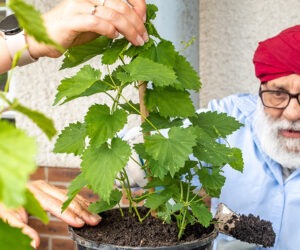Annie Johnson: Homebrewer of the Year

But of course it’s not just the style of beer that makes AHA judges stand up and take notice — it’s how well the beer is made. And Annie delivered the goods, winning in the light lager category and earning more points than any of the other winning beers in the other 25 categories to make Best of Show — which is the criteria for winning Homebrewer of the Year.
Annie started homebrewing around 1999 because she always loved beer. She was born in Germany and was fascinated by her mother’s collection of German beer steins as a girl.
“My mom was the one who encouraged me to go for it,” Annie said about learning to brew. After becoming interested in cooking, she developed an interest in beer and wine, which is when her mom said, “You can make your own!”
Like many homebrewers, Annie’s first batch came from a beer kit she received as a present from a friend. It wasn’t long after that that she and her friend would get together to watch football and brew beer. When her friend moved to Delaware, that was almost the end of the line — but about a month later all of the homebrewing equipment that had moved to Delaware showed up on Annie’s doorstep . . . along with a case of Dogfish Head beer.
In 2001 she entered her first homebrew competition in the California State Fair and won first place for an American amber.
“That was when I got to the point where not only was I making good beer, but I got that competition bug,” she said. Along with entering competitions, she also became a Beer Judge Certification Program judge, which further broadened her palate for different beer styles. She brews what she likes, mostly lagers, Belgian styles and porters, based on the season.
“I love Belgian beers. I took two years of my homebrewing and just devoted it to Belgian beers,” she said. “I did all the reading and went through the different styles — took my time. It was fun — there was so much to do.”
Her advice for brewing award-winning beer is simple: read up on the style, follow recipe directions, and wait until the end of the brew day to have a homebrew.
“I never drink when I homebrew,” she said. “You’re more apt to make a mistake. You don’t pay attention. Sometimes you’re having a good time drinking a beer and then you’re too tired to cool down your carboy. Or you don’t take a reading. Little things like that. I wait until I pitch the yeast and start cleaning up before I have a beer. It is so much more satisfying.”
As for her big win being inspirational to other brewers, Annie takes it in stride.
“I didn’t go into it to be an inspiration, but now that I won I have been asked to speak to lots of homebrew clubs,” she said. “I’m finding out that it is inspirational to many other female brewers. I don’t think about brewing being a female, and I never think about it in terms of race. I’m just a homebrewer — I’m just a
home cook.”
To brew Annie’s winning American light lager (a recipe she made based on a Brew Your Own recipe of the same name), see below.
Mow the Damn Lawn
(5 gallons/19 L, all-grain)
OG = 1.040 FG = 1.009IBU = 12 SRM = 2 ABV = 4%
Ingredients
5 lbs. (2.3 kg) 2-row pale malt
2 lbs. (0.9 kg) rice syrup solids
2 AAU Domestic Hallertau hops (60 mins) (0.5 oz./14 g at 3.9% alpha acids)
2 AAU Domestic Hallertau (20 mins) (0.5 oz./14 g at 3.9% alpha acids)
White Labs WLP840 (American Pilsner) yeast
Step by Step
This is a step infusion mash. Target your water profile to be very soft water similar to Pilsen (~25 ppm HCO3-), utilize a larger portion RO or distilled water if your tap water is hard. Mix 7 qts. (6.6 L) strike water with the crushed grain to achieve a starting mash temp of 145 °F (63 °C) and hold for 120 mins. Raise mash temperature to 158 °F (70 °C) and hold for 10 mins. Raise mash temp to mash out at 168 °F (76 °C) and hold for 5 mins. Batch sparge with 170 °F (77 °C) water. Boil for 60 minutes, adding the hops as instructed. Target pitching rate at 2.0 million cells/ milliliter/degrees Plato (~2 L starter). Ferment at 52 °F (11 °C) for 3 weeks. Lager for 6 weeks at 32 °F (0 °C)
Extract option:
For extract, replace the 2-row with 2.5 lbs. (1.13 kg) light dry malt extract or 3 lbs. (1.4 kg) light liquid malt extract. Add extract and bring to a boil. Follow remainder of instructions for the all-grain version.



